|
TABLE A. Summary of Construction Statistics from Approved Building Permits, Philippines
|
||||||
|---|---|---|---|---|---|---|
| Second Quarter 2020, First Quarter 2020 and Second Quarter 2019 | ||||||
| Type of Construction |
Second Quarter 2020p |
First Quarter 2020r | Second Quarter 2019 | |||
| Level |
Annual |
Level |
Annual |
Level |
Annual |
|
|
Total |
||||||
| Number |
16,004 |
-65.5 | 32,445 | -24.7 | 46,453 | 5.4 |
| Floor Area (sq.m.) |
2,505,356 |
-77.2 | 8,236,572 | -18.7 | 10,991,300 | 11.5 |
| Value (PhP '000) |
25,018,516 |
-81.2 | 89,683,080 | -21.6 | 132,889,906 | 15.9 |
|
Residential |
||||||
| Number |
12,004 |
-65.3 | 21,591 | -28.5 | 34,572 | 7.6 |
| Floor Area (sq.m.) |
1,294,321 |
-77.1 | 3,604,417 | -20.2 | 5,658,832 | -1.2 |
| Value (PhP '000) |
12,496,490 |
-81.9 | 38,225,081 | -20.5 | 69,065,401 | 2.7 |
|
Non-residential |
||||||
| Number |
2,265 |
-64.0 | 6,024 | -12.7 | 6,297 | 3.7 |
| Floor Area (sq.m.) |
1,195,309 |
-77.0 | 4,477,562 | -17.6 | 5,186,537 | 30.5 |
| Value (PhP '000) |
11,912,720 |
-78.6 | 45,962,617 | -20.4 | 55,604,943 | 38.7 |
|
Addition |
||||||
| Number |
347 |
-78.6 | 1,254 | -21.8 | 1,619 | 0.7 |
| Floor Area (sq.m.) |
15,726 |
-89.2 | 154,593 | -13.9 | 145,931 | -8.4 |
| Value (PhP '000) |
114,528 |
-89.7 | 1,700,373 | -13.2 | 1,117,338 | -6.8 |
|
Alteration and Repair |
||||||
| Number |
1,388 |
-65.0 | 3,576 | -18.7 | 3,965 | -7.1 |
| Value (PhP '000) |
494,778 |
-93.0 | 3,795,009 | -42.8 | 7,102,223 | 16.0 |
p – preliminary; r- revised
Note: Details of floor area and value may not add up to their respective totals due to rounding.
Source: Philippine Statistics Authority
Number of Constructions
- Number of constructions declined
The number of constructions in the second quarter of 2020 recorded a total of 16,004, which indicates an annual decline of -65.5 percent. In the previous quarter, the number of constructions decreased at an annual rate of -24.7 percent and in second quarter of 2019, it increased by 5.4 percent. (Table A)
- Residential had the highest number of constructions
By type of construction, residential reported the highest number of constructions during the quarter at 12,004 or 75.0 percent of the total number of constructions. This type of construction dropped at a faster rate of -65.3 percent than its annual rate in the previous quarter of -28.5 percent. Majority (87.2%) of the residential constructions were single-type houses.
Next to residential constructions were non-residential which comprised 14.2 percent of the total constructions during the quarter. Non-residential constructions also dropped at annual rate of -64.0 percent. About two-thirds (63.6%) of the non-residential constructions were commercial buildings. (Tables A and 1, and Figure 1)
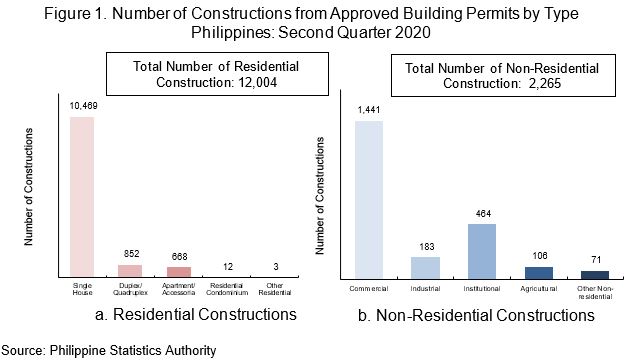
Addition, which refers to any new construction which increases the height or area of an existing building/structure, and alteration and repair of existing structures had shares of 2.2 percent and 8.7 percent, respectively, to total constructions during the period. Both types of constructions also declined at faster annual rates of -78.6 percent for addition and -65.0 percent for alteration and repair, compared with their respective annual rates in the previous quarter. (Tables A and 1)
- Number of constructions was highest in CALABARZON
CALABARZON registered the highest number of constructions with 2,641 or 16.5 percent share to total during the quarter. Completing the top three regions, in terms of number of constructions, were Central Visayas with 2,347 constructions (14.7%) and Ilocos Region with 1,737 constructions (10.9%). (Table 2 and Figure 2)
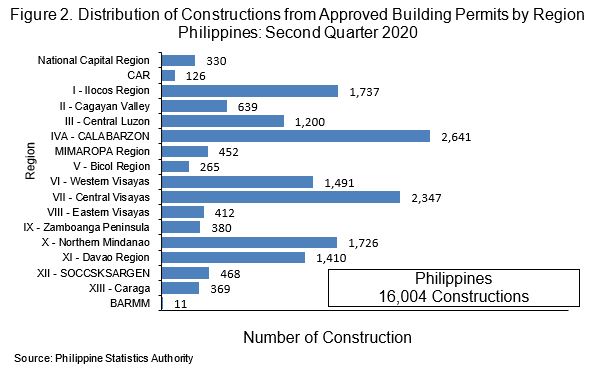
Value of Constructions
- Total value of constructions shrank
In the second quarter of 2020, the total value of constructions amounted to PhP 25.0 billion which shrank by -81.2 percent. Relative to previous quarter, value of constructions declined at an annual rate of -21.6 percent, while it increased at an annual rate of 15.9 percent in the second quarter of 2019. (Tables A and 1)
- Residential and non-residential constructions accounted for almost the entire value of constructions
Residential building constructions, valued at PhP 12.5 billion, accounted for almost half (49.9%) of the total value during the quarter. This construction value plunged by -81.9 percent from its amount of PhP 69.1 billion in the same quarter of 2019.
Construction value of non-residential buildings amounted to PhP 11.9 billion or 47.6 percent of the total value during the quarter. This reflects a -78.6 percent decrease from the PhP 55.6 billion value of construction in the same quarter of the previous year. (Tables A and 1, and Figure 3b)
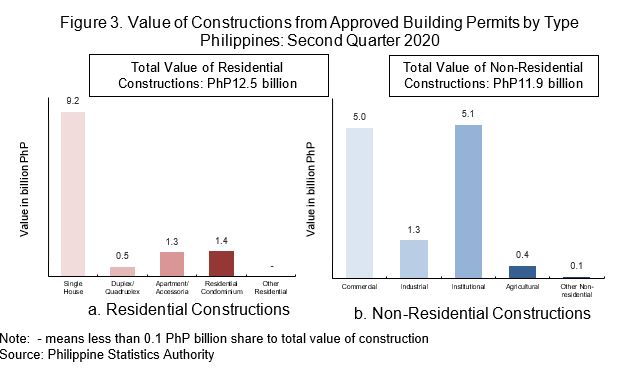
The value of construction for addition, and alteration and repair of existing structures shared PhP 0.1 billion (0.5%) and Php 0.5 billion (2.0%), respectively, to the total value during the quarter. Both types of constructions decreased an annual rate of -89.7 percent for addition and -93.0 percent for alteration and repair of existing structure. (Tables A and 1)
- Top three regions contributed more than half to the total value of constructions
The combined shares of the top three regions, in terms of value of constructions, amounted to PhP 9.5 billion (37.9%). These regions were:
- CALABARZON, PhP 3.7 billion (14.7%)
- Central Visayas , PhP 3.3 billion (13.0%)
- Northern Mindanao, PhP 2.5 billion (10.1%) (Figure 4)
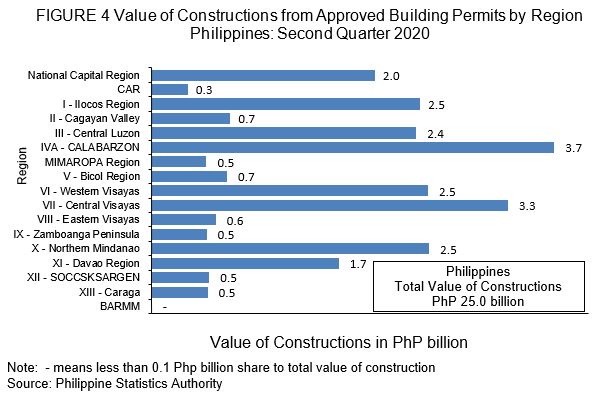
Floor Area
- Total floor area of constructions decreased
The total floor area of constructions for this quarter was recorded at 2.5 million square meters which indicated a decline of -77.2 percent. This was faster than the previous quarter’s annual drop of -18.7 percent. On the other hand, it increased at an annual rate of 11.5 percent in the second quarter of 2019. (Table A)
- Residential comprised more than half of the total floor area of constructions
Residential constructions accounted for 1.3 million square meters or more than half (51.7%) of the total floor area of constructions this quarter. Floor area from this type of construction continued to drop with its annual rate of -77.1 percent for this quarter.
On the other hand, non-residential recorded 1.2 million square meters or 47.7 percent of the total floor area of constructions. Floor area of non-residential construction decreased at a faster rate of -77.0 percent compared with its previous quarter’s annual rate of -17.6 percent. (Table 1)
Average Cost per Square Meter
- Average cost of construction contracted
The average cost, excluding those for alteration and repair, in the second quarter of 2020 was valued at PhP 9,789 per square meter, which indicates an annual decline of -14.5 percent. The average cost per square meter in the previous quarter also contracted but at a slower annual rate of -3.5 percent. In the second quarter of 2019, average cost of construction increased by 4.0 percent. (Table 1)
- Non-residential had the highest average cost of constructions
Among types of constructions, non-residential had the highest average cost per square meter of PhP 9,918 during the quarter. This was followed closely by residential with PhP 9,655 per square meter and addition with PhP 7,283 per square meter. (Table 1)
- Residential condominium type of constructions was the most expensive among types of residential construction
Among residential constructions, condominium type posted the highest average cost of PhP 12,495 per square meter during the quarter. On the other hand, the lowest average cost per square meter of PhP 7,481 was observed in duplex/quadruplex. (Table 1 and Figure 5a)
- Institutional-type buildings remained the costliest among non-residential buildings
Institutional-type building constructions still recorded the highest average cost of PhP 13,013 per square meter this quarter. On the other hand, agricultural-type building constructions continued to register the lowest average cost of PhP 5,006 per square meter. (Table 1 and Figure 5b)
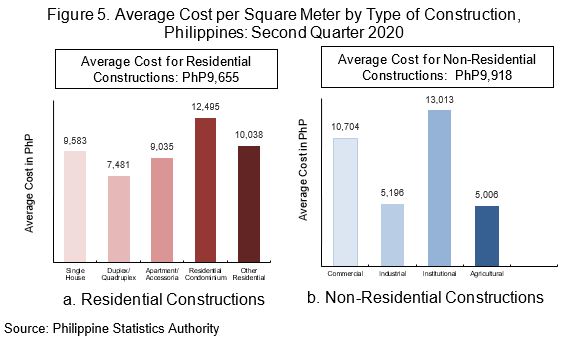
DENNIS S. MAPA, Ph.D.
Undersecretary
National Statistician and Civil Registrar General
TECHNICAL NOTES
Introduction
This Special Release presents the preliminary data on construction statistics from approved building permits for the second quarter of 2020. Data are presented in monthly and quarterly statistical tables at the regional and provincial level by type of construction.
Scope and Coverage
Construction statistics presented in this special release are based on approved building permits on new constructions and additions, alterations and repairs of existing residential and non-residential buildings, and other structures which are proposed to be constructed in the different cities/municipalities of the country.
Sources of Information
Construction statistics are generated from approved building permits as well as from the demolition and fencing permits collected every month by PSA field personnel from the Offices of Local Building Officials (LBOs).
Limitations of data
- Data on building constructions are based on approved applications for construction during the reference period and not on the construction work completed during the reference period.
- The completeness of construction data relies on the approved applications filed with the LBOs. Hence, building constructions without approved building permits are not part of the tabulation of data.
Geographic Classification
For the second quarter of 2020, building constructions are classified and presented by geographic area using the Philippine Standard Geographic Classification (PSGC) as of December 2017.
Statistics Generated
Construction statistics generated from approved building permits provide monthly data on building construction at the regional and provincial level. The statistics generated are the following:
- number
- floor area
- type of construction
- value of construction
Aside from the preliminary tables posted in the PSA website, the annual, quarterly, and monthly statistical tables at the municipality level by type of construction are available at the Industry Statistics Division (ISD) of the Economic Sector Statistics Service (ESSS) of the PSA. They can be requested through email at nonmfg.staff@psa.gov.ph.
Dissemination
Preliminary results of construction statistics are made public in the form of Quarterly Special Releases. The Quarterly Special Releases are reports containing the preliminary results of construction statistics submitted within the cut-off dates for each month. Results are posted 65 days after the reference quarter in the PSA website (www.psa.gov.ph).
Definition of Terms (Adopted from the Revised and Updated IRR of the National Building Code)
Building permit is a written authorization granted by the LBO to an applicant allowing him to proceed with the construction of a specific project after plans, specifications and other pertinent documents have been found to be in conformity with the National Building Code (PD 1096).
Building refers to any independent, free-standing structure comprised of one or more rooms or other spaces, covered by a roof and enclosed with external walls or dividing walls, which extend from the foundation to the roof.
Construction refers to all on-site work done from site preparation, excavation, foundation, assembly of all the components and installation of utilities, machineries, and equipment of buildings/structures.
Residential building is a building for which its major parts or more than half of its gross floor area is built for dwelling purposes. This type of building can be of the single type, duplex, apartment and/or accessoria, and residential condominium.
Single house is a complete structure intended for a single family or household, i.e., bungalow, 2-storey house, nipa hut, etc.
Duplex house is a structure intended for two households, with complete living facilities for each; it is a single structure divided into two dwelling units by a wall extending from the floor to the ceiling.
Apartment is a structure, usually of two storeys, made up of independent living quarters, with independent entrances from internal walls and courts.
Accesoria is a one or two-floor structure divided into several dwelling units, each dwelling unit having its own separate entrance from the outside.
Residential condominium is a structure, usually of several storeys, consisting of multiple dwelling units.
Other residential construction consists of school or company staff houses, living quarters for drivers and maids, and guardhouses.
Non-residential building includes commercial, industrial, agricultural and institutional buildings.
Commercial buildings refer to office buildings and all buildings which are intended for use primarily in wholesale, retail and service trades; i.e., stores, hotels, restaurants, banks, disco houses, etc.
Industrial buildings are buildings used to house the production, assembly and warehousing activities of industrial establishments; i.e., factories, plants, mills, repair shops, machine shops, printing press, storage plant, electric generating plants.
Institutional buildings are buildings which primarily engaged in providing educational instructions and hospital/health care; ports, airports and other government buildings; i.e. school, museums, libraries, sanitaria, churches, hospitals.
Agricultural buildings are buildings used to house livestock, plants and agricultural products such as barn, poultry house, piggeries, stables, greenhouses and grain mill.
Other non-building constructions include cemetery structures, street furniture, waiting sheds, communication towers, etc.
Addition refers to any new construction which increases the height or area of an existing building/structure.
Repair is a remedial work done on any damaged or deteriorated portion/s of a building/structure to restore its original condition.
Renovation is any physical change made on structures to increase their value and quality.
Alteration is a construction in a building/structure involving changes in the materials used, partitioning and location/size of openings, structural parts, existing utilities and equipment but does not increase the overall area thereof.
Conversion is a change in the use or occupancy of structure or any portion thereof, which has different requirements.
Demolitions refer to the systematic dismantling or destruction of a building/structure, in whole or in part.
Street furniture are street structures consisting of monuments, waiting sheds, benches, plant boxes, lampposts, electric poles, and telephone poles.
Floor area of building refers to the sum of the area of each floor of the building measured to the outer surface of the outer walls including the area of lobbies, cellars, elevator shafts and all communal spaces in multi-dwellings. Areas of balconies are excluded.
Total value of construction refers to the sum of the cost of building, electrical, mechanical, plumbing, and others. The value is derived from the approved building permit and represents the estimated value of the building or structure when completed.
